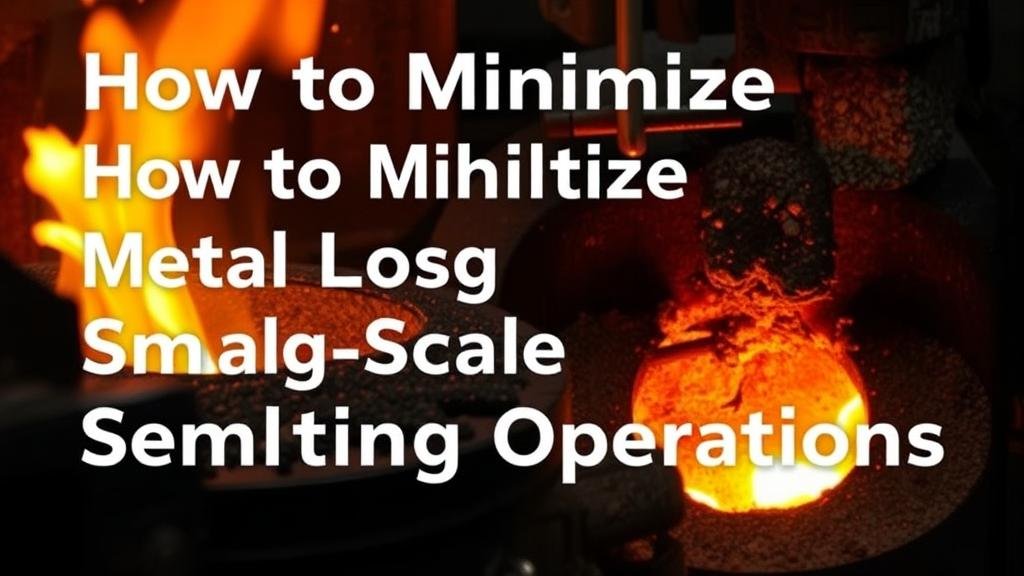How to Minimize Metal Loss During Small-Scale Smelting Operations
How to Minimize Metal Loss During Small-Scale Smelting Operations
The smelting process, while essential for metal extraction, often leads to significant material losses if not managed carefully. Metal loss during small-scale smelting operations can arise from several avenues, including oxidation, slag formation, and inadequate temperature control. This article discusses strategies to minimize such losses, supported by industry-standard practices and real-world examples.
Understanding Metal Loss in Smelting
Metal loss in smelting operations typically occurs due to three primary mechanisms: oxidation, physical losses, and chemical losses. Understanding these mechanisms is crucial for effective management.
- Oxidation: During smelting, certain metals can react with oxygen in the atmosphere, leading to oxidation. For example, copper can form copper oxides which are often discarded as waste.
- Physical Losses: This often occurs when metals are lost during the transfer process, whether from spillage or inadequate recovery techniques.
- Chemical Losses: This type of loss arises from the formation of slag–a by-product made up of impurities and metal oxides. While some slag can contain recoverable metal, it often represents metal loss overall.
Minimizing Oxidation
To reduce oxidation losses during the smelting process, it is vital to control the environment in which smelting occurs. Here are some strategies:
- Use of Reducing Agents: Introducing reducing agents such as carbon can help maintain a non-oxidizing environment. In the case of copper smelting, carbon monoxide can effectively reduce metal oxides back to their metallic form.
- Controlled Atmosphere Furnaces: Employing furnaces that allow for controlled atmospheres can significantly curtail oxidation. An example is the use of vacuum furnaces, which have demonstrated reductions in metal losses by minimizing exposure to oxygen.
Addressing Physical Losses
Physical losses can often be mitigated through careful operational practices:
- Effective Handling Techniques: Useing better handling techniques during the transport of raw materials and the finished product can drastically reduce spillage. For example, utilizing lidded containers can minimize the chance of material loss during movement.
- Recycling Slag: Sorting and recycling slag rather than discarding it can ensure that recoverable metals are not lost. For example, using slag reprocessing units can enable the recovery of metals from slag, as demonstrated by studies in small-scale gold smelting operations.
Improving Chemical Recovery
Enhancing recovery rates can also help minimize losses due to slag formation. Methods include:
- Optimizing Smelting Temperature: Maintaining an optimal smelting temperature can prevent the formation of excess slag. High temperatures can increase metal loss as impurities are more likely to form solid instead of returning to the molten state.
- Alloying Techniques: Adding specific alloying materials can change the melting characteristics and reduce the amount of unwanted slag. For example, alloying lead with antimony during smelting reduces the formation of lead oxide.
Utilizing Advanced Technologies
Modern smelting technologies present robust solutions to metal loss challenges:
- Induction Furnaces: These provide precise temperature control and reduced overall oxidation due to their enclosed design. Induction smelting has shown to significantly reduce metal loss when compared to traditional methods.
- Leaching and Electrolysis: Following smelting, processes like leaching and electrolysis can recover metals from smelting by-products. For example, leaching copper from slag can recover up to 80% of the metal content, as evidenced by studies in small-scale operations in Latin America.
Conclusion
Minimizing metal loss during small-scale smelting operations is not only pivotal for economic sustainability but also for environmental stewardship. By understanding the mechanisms of metal loss and implementing best practices such as using controlled atmospheres, optimizing temperatures, and employing advanced technologies, operators can significantly enhance their recovery rates.
As industries move toward more sustainable practices, the integration of these methods will become increasingly critical. For those engaged in small-scale smelting, prioritizing these strategies can lead to a more efficient and profitable operation.
Actionable Takeaways:
- Use reducing agents and maintain controlled atmospheres to minimize oxidation.
- Adopt effective handling techniques and recycling methods to reduce physical losses.
- Optimize smelting temperature and explore alloying techniques to enhance chemical recovery.
- Invest in modern technologies such as induction furnaces and leaching processes for better efficiency.



